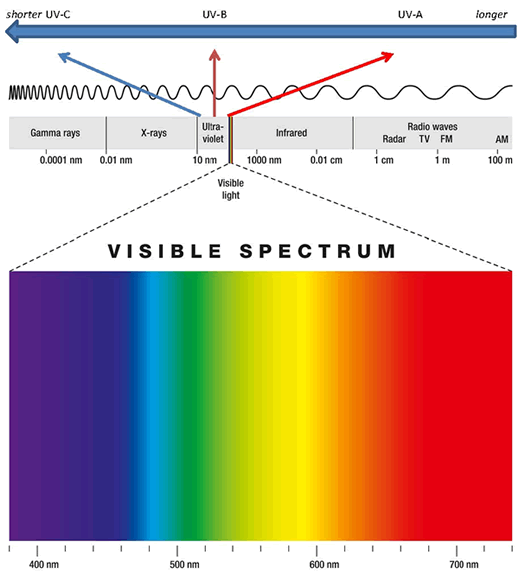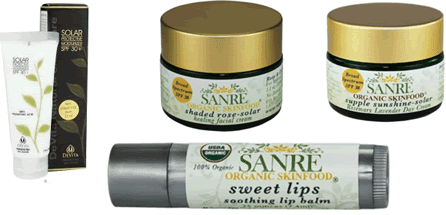We tell you to get out in the sun, so that your skin can manufacture enough Vitamin D to maintain a healthy metabolism.
And then we tell you to stay out of the sun, because it causes skin cancer, and you should protect yourself against the rays of the sun at all costs.
Where is the logic?
Do you remember the days (in your grandparents' time) when TB Sanitaria were located in the country, and the patients were exposed to fresh air and sunlight every day? Many of those patients actually did heal from their infection with tuberculosis, in the days before antibiotics.
Why in the world are we recommending sun blockers if ultraviolet light is so important to our health? Why is there so much hype in the media about the idea that sunlight is bad for us, and causes cancer?
Sunlight at the right frequency activates a part of the immune system called "Toll-like Receptors" (TLR) which in turn activate some white blood cells called macrophages. These macrophages are designed to recognize self from non-self, so that when they encounter a foreign organism like a bacterium, they will engulf the bacterium, digest it and destroy it, in part by activating Vitamin D receptors.[1]
 So... does sunlight cause cancer or cure it?
So... does sunlight cause cancer or cure it?
And if we do choose to get out in the sun, to activate our Vitamin D receptors, how much danger do we put ourselves in because of that radiation exposure that we are warned against?
What is radiation anyway? How is it that UV light can be used to sterilize products in the market[2], but it does not kill us when we are exposed? Or does it? Hm-m-m…
It's all a question of balance. Too much sunlight leads to skin cancer. Too little leads to low vitamin D levels and susceptibility to both cancer and infection. "Ultraviolet radiation (UVR) is the major etiologic agent for these cancers, but is also the principal means by which the body obtains vitamin D."[3]
Radiation within the UV spectrum can be divided by wavelength into UVC (200-280 nm), UVB (280-320 nm) and UVA (320-400 nm). Ultraviolet light on the above frequencies can change the electrical properties of molecules and induce chemical reactions.
More UVA reaches the earth than any of the other ultraviolet frequencies. UVB is more inflammatory than UVA, and less of it reaches the earth normally. Some wavelengths of UV radiation can activate components of the immune system and cause DNA damage, cell death, and release of antigens to self. DNA absorbs radiation at these wavelengths.
Not all UV-induced reactions are dangerous. One wavelength in the UVB spectrum (280 µm) strongly induces the formation of Vitamin D from a molecule derived from cholesterol. However, this wavelength is pretty much blocked by normal skin[4], nor is this wavelength significantly present in sunlight which reaches the earth.
The effect of UV radiation depends upon the dose, like so many other things in the human body.
The effect of ionizing radiation also depends on the dose. When radiation therapy is used in the treatment of cancer, it is intended to cause cell death - of those cells which are cancerous. There is, of course, collateral damage to the normal cells, hence the "side effects" of radiation burns, inflammation of the lungs (pneumonitis) or the heart (carditis) or the colon (colitis) or the rectum (proctitis).
These so-called "side effects" are actually perfectly normal effects of ionizing radiation, such as x-rays or gamma radiation, which carry enough energy to remove electrons from molecules in a cell. When electrons are removed from molecules, ions called free radicals are formed. Free radicals can damage most other molecules in a cell, such as DNA or RNA, by oxidizing them. The "gamma knife" works by directing a narrow beam of ionizing radiation at a tumor, hoping to kill the tumor cells without killing too many surrounding normal cells.
Non-ionizing radiation, such as ultraviolet (UV) light, can cause mutation in a different way. UV light can take electrons in molecules to a higher energetic state. The excitation of electrons in DNA molecules may result in the formation of extra bonds between parts of the DNA molecule, which may change the shape of the DNA in the cell. The cell often tries to repair the DNA before cell division occurs, but the repair mechanism itself can also lead to mutations.
 As the wavelength of the radiation decreases the energy emitted by the radiation increases.
As the wavelength of the radiation decreases the energy emitted by the radiation increases.
UVa and UVb have a longer wavelength than UVc; therefore, they have less energy and cannot penetrate cells as well. While they are still dangerous, they are not considered germicidal because they produce only a small effect on most microbes.
Did you ever wonder why, if sunlight is such a great activator of Vitamin D, we don't experience Vitamin D toxicity? It turns out that Vitamin D synthesis is not just stimulated, but also regulated (or modulated) by sunlight, because different precursors are maximally activated at different wavelengths of the UVB spectrum between 280 and 340 µm. We do not "overdose" on Vitamin D because the different precursors modulate the synthesis of Vitamin D itself, depending on which precursor is the most abundant.[5]
Does oral supplementation have an impact on Vitamin D levels within the skin?[6] Vitamin D has two distinct functions. (1) in the immune system, it is actively produced by macrophages, acting locally as a response to infection with pathogenic organisms. (2) in the regulatory networks, it is also a hormone affecting calcium absorption in the gut and mobilization of calcium from the skeleton. In order to produce the active form, Vitamin D precursors must be synthesized and activated within the dermis, or ingested in the form of supplements. Once the precursors are available, our liver and kidneys do the actual work of synthesizing the actual active form of the vitamin - 1,25 2(OH) Vitamin D.
It is possible to overdose on supplemental oral vitamin D? Mother Nature provided us with automatic safeguards. When we decide to override Mother Nature, we have to rely on our own common sense and laboratory measurements. A level of oral supplementation somewhere around 1000 IU per day appears to be very safe. Higher levels are sometimes used to "fill up the tank", but should probably not be taken for more than a few weeks without checking blood levels.
Conclusion:
We recommend using a sunscreen if you are going to be out in the sun for longer than 20 minutes or so, to avoid the excessive radiation exposure and wrinkly skin, skin cancers, etc, seen in the "sun worshippers".
Use a sunscreen which is chemically safe, so that you are not exposed to any more cancer-causing chemicals. We have found several products that fit the bill, and we have these available in the office for purchase.
Non-melanoma skin cancers (NMSC) are the most common type of cancer, occurring at a rate of over 1 million per year in the United States. Although their metastatic potential is generally low, they can and do metastasize, especially in the immune compromised host, and their surgical treatment is often quite disfiguring. Ultraviolet radiation (UVR) as occurs with sunlight exposure is generally regarded as causal for these malignancies, but UVR is also required for vitamin D synthesis in the skin. Based on our own data and that reported in the literature, we hypothesize that the vitamin D produced in the skin serves to suppress UVR epidermal tumor formation. In this review we will first discuss the evidence supporting the conclusion that the vitamin D receptor (VDR), with or without its ligand 1,25-dihydroxyvitamin D, limits the propensity for cancer formation following UVR. We will then explore three potential mechanisms for this protection: inhibition of proliferation and stimulation of differentiation, immune regulation, and stimulation of DNA damage repair (DDR).

[1] Liu PT et al. Toll-Like Receptor Triggering of a Vitamin D-Mediated Human Antimicrobial Response. Scienceexpress www.sciencexpress.org / 23 February 2006 / Page 1/ 10.1126/science.1123933
[2] Furlong M. Effects of UV Light Exposure on Bacteria. Microbiology for Health Science Lab.Downloaded 7/13/2014.
[3] Bikle DD. Protective actions of vitamin D in UVB induced skin cancer. Photochem Photobiol Sci. Author manuscript; available in PMC Dec 1, 2013.
[4] Hume EM et al. On the Absorption of Vitamin D from the Skin. Biochem J. 1927; 21(2): 362-367.
[5] MacLaughlin JA, Anderson RR, Holick MF. Spectral character of sunlight modulates photosynthesis of previtamin D3 and its photoisomers in human skin. Science. 1982 May 28;216(4549):1001-3.
[6] Gilchrest BA. Sun exposure and vitamin D sufficiency. Am J Clin Nutr August 2008 vol. 88 no. 2 570S-577S
